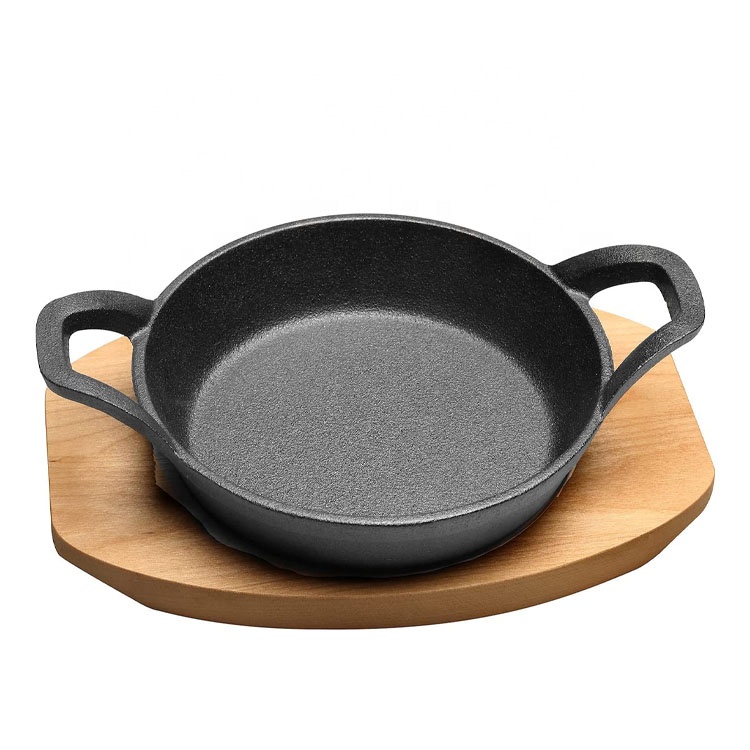
divided cast iron skillet
Divided Cast Iron Skillets A Culinary Marvel
Cast iron skillets have long been celebrated as a cornerstone of kitchens around the world, cherished for their heat retention, versatility, and natural non-stick properties when properly seasoned. Among the myriad designs available, the divided cast iron skillet has emerged as a revolutionary tool for home cooks, allowing for a multi-faceted approach to meal preparation.
What is a Divided Cast Iron Skillet?
A divided cast iron skillet is a cooking surface that features separate compartments, similar to a divided plate. This design enables cooks to prepare multiple dishes or different components of a meal simultaneously without the flavors mixing. Typically, these skillets come with two, three, or even four divisions, each with its own unique shape and size. The skillets retain the classic benefits of traditional cast iron—excellent heat distribution, durability, and the ability to develop a well-seasoned surface over time.
Advantages of Using a Divided Cast Iron Skillet
1. Efficiency in Cooking One of the primary advantages of a divided cast iron skillet is its ability to streamline cooking processes. For busy individuals and families, having separate sections allows for a quicker and more organized preparation of meals. For instance, you can cook eggs in one compartment while sautéing vegetables in another, saving both time and effort.
2. Flavor Control The divisions in the skillet help maintain distinct flavors, making it ideal for cooking a variety of dishes at once. This feature is particularly useful when preparing a meal that includes elements like protein, starch, and vegetables that may not pair well together. You can easily cook a savory chicken breast, crispy potatoes, and roasted asparagus all in one go without worrying that the flavors will bleed into one another.
3. Versatility A divided cast iron skillet can accommodate a wide range of cooking methods—from frying and baking to sautéing and even roasting. This versatility makes it a valuable addition to any kitchen, whether for casual family dinners or more elaborate gourmet meals. Additionally, the skillet can be used both on the stovetop and in the oven, further expanding its culinary applications.
divided cast iron skillet

4. Healthier Cooking Using a cast iron skillet often encourages healthier cooking practices. Since cast iron requires less fat to create a non-stick surface compared to traditional non-stick pans, you can prepare meals with lower amounts of oil or butter. This makes the divided skillet an excellent choice for those looking to prepare healthier options without sacrificing flavor.
5. Durability and Sustainability Cast iron skillets are incredibly durable and long-lasting when taken care of properly. A divided cast iron skillet can last for generations, making it a sustainable choice for eco-conscious consumers. Moreover, the ability to achieve a natural non-stick surface by seasoning the skillet means that you can avoid the chemicals often found in other non-stick cookware.
Care and Maintenance
To ensure the longevity of your divided cast iron skillet, it’s essential to follow a few care tips
- Season Regularly Regular seasoning helps maintain the non-stick surface and prevents rust. After each use, clean the skillet thoroughly, dry it completely, and apply a thin layer of vegetable oil before storing. - Avoid Soaking Cast iron should not be soaked in water, as this can lead to rust. Instead, use a gentle scrubber to clean off any food residue.
- Heat Gradually Always heat your cast iron skillet gradually to prevent warping and cracking, which can occur if subjected to sudden temperature changes.
In conclusion, a divided cast iron skillet is more than just a cooking tool; it's a culinary companion that enhances the cooking experience. Its efficiency, versatility, and flavorful results make it a valuable asset in any kitchen. Whether you're a novice cook or a seasoned chef, investing in a divided cast iron skillet will undoubtedly elevate your culinary adventures, bringing creativity and convenience to your kitchen.
-
Season Cast Iron Perfectly with GPT-4 Turbo TipsNewsAug.01,2025
-
High Quality Cast Iron Cookware - Baixiang County Zhongda MachineryNewsAug.01,2025
-
Premium Cast Iron Pan: Durable & Perfect HeatNewsAug.01,2025
-
High Quality Kitchen Durable Black Round Cast Iron Cookware Pancake Crepe Pan-Baixiang County Zhongda Machinery Manufacturing Co., Ltd.NewsAug.01,2025
-
Cast Iron Cookware - Baixiang County Zhongda Machinery | Nonstick, Heat ResistanceNewsAug.01,2025
-
High Quality Kitchen Durable Black Round Cast Iron Cookware - Baixiang County Zhongda Machinery | Non-Stick, Heat Retention, DurableNewsJul.31,2025


